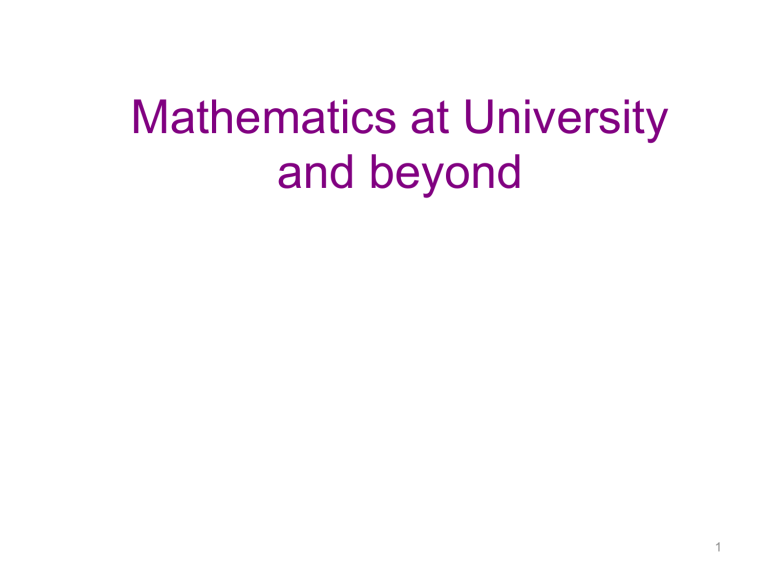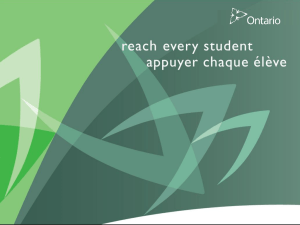Guide to Higher Education Maths Courses Powerpoint

Mathematics at University and beyond
1
Maths Is Important
Mathematics is a universal part of human culture. It is the tool and language of commerce, engineering and other sciences – physics, computing, biology etc.
It helps us recognise patterns and to understand the world around us.
Mathematics plays a vital, often unseen, role in many aspects of modern life, for example:
•Space travel
•Safeguarding credit card details on the internet
•Modelling the spread of epidemics
•Predicting stock market prices
•Business decision making
As society becomes more technically dependent, there will be an increasing requirement for people with a high level of mathematical training.
Analytical and quantitative skills are sought by a wide range of employers.
A degree in mathematics provides you with a broad range of skills in problem solving, logical reasoning and flexible thinking.
This leads to careers that are exciting, challenging and diverse in nature.
Whatever your career plans, or if you have no plans at present, a degree in mathematics provides you with particularly good job prospects
Why study mathematics ?
history music sociology french biology sport science art history english literature geography
3
Because
...
• you love it
• it's interesting
• it's easy
• it's a conversation stopper
• it's beautiful
• it's difficult
4
Other good reasons
...
• 5 years after graduating those with mathematics degrees earn more on average than any other graduates.
• 96% of 2012/2013 mathematics graduates are now employed, higher than any other subject apart from medicine and dentistry.
5
Maths Has Good Career Prospects
Analytical and quantitative skills are sought by a wide range of employers.
A degree in mathematics provides you with a broad range of skills in problem solving, logical reasoning and flexible thinking.
This leads to careers that are exciting, challenging and diverse in nature
Whatever your career plans, or if you have no plans at present, a degree in mathematics provides you with particularly good job prospects
The generic nature of mathematics means that almost all industries require mathematicians. Mathematicians work in business, finance, industry, government offices, management, education and science.
A proportion of students will use their degree in mathematics as preparation for further studies at Masters or Doctorate levels.
The experience gained through a sandwich course increases your employability even further. The opportunity of a year's salaried work experience during your degree enables you to try a job of your choosing and provides employers with evidence of your achievements and skills.
For more information on the types of placements available please click here .
Cardiff's Mathematics graduates for the year 2012 their destinations were as follows:
37% Professions/Commerce (e.g. Finance, Computing etc.)
9% Industry
17% Public Service
12% Teaching
25% Research and further study
Studying mathematics allows you to keep your career options open.
Recent mathematics graduates at
Cardiff have joined:
American Express
Asda
Automobile Association
AXA Insurance
Barclays Bank
Bacon & Woodrow
British Aerospace
British Airways
British Telecom
Charles Schwab
Cheltenham & Gloucester
Clerical Medical Investment Group
Coopers & Lybrand
DEFRA rnst & Young
GEC Avionics
General Accident
Glaxo Smith Klein
Glencore UK Ltd.
HBOS
HSBC
KPMG
Lloyds TSB
MGM Assurance
Motorola
National Air Traffic Services
National Assembly for Wales
NatWest Bank
Norwich Union
Office for National Statistics
PA Consulting
Patents Office
Pearl Assurance
Price Waterhouse Coopers
QinetiQ
RM Computers
Somerfield
Standard Life Bank
Sun Life Assurance
Vodafone
Waterstons
Mathematics at University
Maths at university
School mathematics is mostly about how to solve particular problems.
For example, examinations usually consist of questions which are solved by selecting a method from a list of methods you have been taught.
This approach changes when you study mathematics at University:
When you go into the world with a degree which says you are a mathematician, you may be asked questions with no obvious method of solution.
For example there are mathematicians developing ways of answering the following questions:
•How can you tell whether a new treatment for a disease offers value for money when the very ideas of value and cost are uncertain?
•How can you investigate the internal structure of the sun when you see only its surface - and from a very long way off?
•How can you relate particle trajectories in space-time to the various ways you can knot pieces of string?
To work on such problems you need to know how mathematicians have tried to answer similar questions in the past - sometimes successfully, sometimes not!
You need to know methods which might give an approximate answer good enough for practical purposes because many real-life problems cannot be given definitive answers!
And perhaps, above all, you need to be able to give a logical argument which guarantees that your conclusions follow from the information you began with.
These conclusions may only be approximate, so your argument should tell you how good your approximation might be.
The main point here is that mathematics not only produces results, but produces results which can be relied upon!
Calculus :
What do you study?
differentiation/integration in higher dimensions
Algebra/Geometry : vectors/matrices/lines/planes/conic sections
Analysis : sequences/series/limits/convergence
Computer programming :
Matlab/Maple
Many other interesting things
How do you learn?
Number of contact hours
A typical term contains:
4 courses
A typical week for each course consists of:
3 hours of lectures
1 hour exercise class
Additional contact hours per week:
1 hour tutorial
Office hours (2x1 hour)
Which University to choose?
Entry requirements
Quality of teaching and support
National Student Survey
Location
The campus
The city
Maths Courses on the UCAS web site
Actuarial Mathematics
Applied Mathematics
Business Mathematics
Computing
Computing Mathematics
Discrete Mathematics
Engineering Mathematics
Environmental Mathematics
Finance Mathematics
General Mathematics
Industrial Applied Mathematics
Industrial Mathematics
Mathematical Science
Mathematics Education
Philosophy Of Mathematics
Pure Mathematics
Secondary Mathematics
Statistics
Actuarial science is the discipline that applies mathematical and statistical methods to assess risk in the insurance and finance industries.
Actuaries are professionals who are qualified in this field through education and experience. In the United Kingdom, and several other countries, actuaries must demonstrate their competence by passing a series of rigorous professional examinations.
Actuarial science includes a number of interrelating subjects, including probability, mathematics, statistics, finance, economics, financial economics and computer programming. Historically, actuarial science used deterministic models in the construction of tables and premiums.
The science has gone through revolutionary changes during the last 30 years due to the proliferation of high speed computers and the union of stochastic actuarial models with modern financial theory
Many universities have undergraduate and graduate degree programs in actuarial science.
In 2010, a study published by job search website CareerCast ranked actuary as the #1 job in the United States.
Applied mathematics is a branch of mathematics that concerns itself with mathematical methods that are typically used in science, engineering, business, and industry.
Thus, "applied mathematics" is a mathematical science with specialized knowledge.
The term "applied mathematics" also describes the professional specialty in which mathematicians work on practical problems; as a profession focused on practical problems, applied mathematics focuses on the formulation and study of mathematical models.
In the past, practical applications have motivated the development of mathematical theories, which then became the subject of study in pure mathematics, where mathematics is developed primarily for its own sake.
Thus, the activity of applied mathematics is vitally connected with research in pure mathematics.
Business mathematics is mathematics used by commercial enterprises to record and manage business operations.
Commercial organizations use mathematics in accounting, inventory management, marketing, sales forecasting, and financial analysis.
Mathematics typically used in commerce includes elementary arithmetic, elementary algebra, statistics and probability.
Business management can be made more effective in some cases by use of more advanced mathematics such as calculus, matrix algebra and linear programming.
Computational science (or scientific computing) is the field of study concerned with constructing mathematical models and quantitative analysis techniques and using computers to analyze and solve scientific problems.
In practical use, it is typically the application of computer simulation and other forms of computation to problems in various scientific disciplines.
The field is distinct from computer science (the study of computation, computers and information processing). It is also different from theory and experiment which are the traditional forms of science and engineering.
The scientific computing approach is to gain understanding, mainly through the analysis of mathematical models implemented on computers.
Scientists and engineers develop computer programs, application software, that model systems being studied and run these programs with various sets of input parameters.
Typically, these models require massive amounts of calculations and are often executed on supercomputers or distributed computing platforms.
Discrete mathematics is the study of mathematical structures that are fundamentally discrete rather than continuous. In contrast to real numbers that have the property of varying "smoothly", the objects studied in discrete mathematics – such as integers, graphs, and statements in logic – do not vary smoothly in this way, but have distinct, separated values.
Research in discrete mathematics increased in the latter half of the twentieth century partly due to the development of digital computers which operate in discrete steps and store data in discrete bits.
Concepts and notations from discrete mathematics are useful in studying and describing objects and problems in branches of computer science, such as computer algorithms, programming languages, cryptography, automated theorem proving, and software development.
Conversely, computer implementations are significant in applying ideas from discrete mathematics to real-world problems, such as in operations research.
Maths Courses on the UCAS web site – with links
Actuarial Mathematics
Applied Mathematics
Business Mathematics
Computing
Computing Mathematics
Discrete Mathematics
Engineering Mathematics
Environmental Mathematics
Finance Mathematics
General Mathematics
Industrial Applied Mathematics
Industrial Mathematics
Mathematical Science
Mathematics Education
Philosophy Of Mathematics
Pure Mathematics
Secondary Mathematics
Statistics
What Grades are Required
A variety of entry grades are listed below
Warwick A* Maths A*F Maths A
Southampton A A A
Exeter A*A B A*AA-AAB
Reading 340pts A in maths
Loughborough
Newcastle
Sussex
Leeds
A A B
A A B
A A A
A A B
UEA A Maths B B
Nottingham A A A
Sheffield A A B
Leicester A A B
Bath A* A A
Manchester
Essex A A B
Birmingham
Aberystwyth
A A B
300 pts B in maths
Plymouth 280 pts B in maths
Kent 300 pts A in maths
Portsmouth 260-300pts
Kingston 280 pts
Lancaster A B B
Bristol
Cardiff
A* A A
A A B
Hertfordshire 240 pts C in maths
Derby 280 pts D in maths
Sheffield Hallam 280pts C in maths
Nottingham Trent 280 pts B in maths
Surrey
Keele
Wolverhampton 160-220pts C in maths
A A B
300 pts A in maths
• Once you have researched your courses and narrowed down your choice of HE establishments you need to begin on your personal statement.
Focus on the subject you wish to study. Your statement should be at least 80% subject specific and only ~20% on other interests.
Try to include subject specific activities outside of your normal class work. This could include books you have read, courses or conferences attended, work experience or links with outside agencies/people.
Try to convey a sense of enthusiasm for your subject. You need to stand out against lots of other applicants.
Destinations of Recent Students
2010
2007
University Maths Department Gradings
University Departmental Gradings other Subjects
Interesting applications of Mathematics
•
Special effects in films
• Pattern formation in nature
• Digital photography
• Medical imaging
26
Mathematics in the Movies
Maths is used in creating many special effects
In order to create realistic animations of smoke , water and fire complicated systems of equations (see next slide) need to be solved
Harry Potter and the Goblet of Fire
Pirates of the
Caribbean
Finding Nemo
The Navier Stokes Equations
(a system of nonlinear partial differential equations)
−
∂ u + 1 ∆ u
+ u · ∇ u
+ ∇ p = 0 in Ω x (0,T),
∂ t
−
Re
∇ · u = 0 in Ω x (0,T),
Here u (x,y,z,t)=(u ,u ,u ) is a vector field denoting the fluid’s velocity p=p(x,y,z,t) is a scalar field denoting pressure
∇ is the vector differential operator del or nabla
∆ = ∇ · ∇ is the scalar differential operator Laplacian
Maths is used in the making of animated movies
When Toy Story was made in 1999 simple , hard , plastic toys were used in the animations
By 2001 when Monsters Inc was made advances in maths helped enable the animation of more visually rich human-like characters
Maths is used in animations to morph one shape into another
Mathematical Biology: pattern formation
By solving relatively simple equations on complicated domains you can obtain many naturally occurring pattern formations
Spots or stripes?
Changing the domain but keeping the coefficients fixed gives rise to different patterns
32
Slightly changing the coefficients in the equation but keeping the domain fixed also gives different patterns
33
Image processing: maths is used in removing noise from digital camera photos
Number Plate Recognition
Similarly MRI scans include random noise which needs to be smoothed out
35







